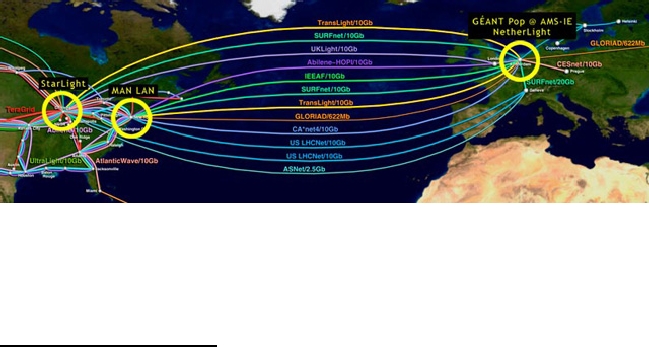Appendix 20. TransLight, a Major US Component of the
GLIF
An Optical Web Connecting Research Networks in North America, Europe and the
Pacific Rim
Tom DeFanti, University of Illinois, Chicago
Maxine Brown, University of Illinois, Chicago
Joe Mambretti, Northwestern University
John Silvester, University of Southern California
Ron Johnson, University of Washington
January 2008
The US National Science Foundation (NSF) funds two complementary efforts through its
International Research Connection Networks (IRNC) program -- TransLight/StarLight30 and
TransLight/Pacific Wave31 -- that provide multi-gigabit links and supporting infrastructure to
interconnect North American, European and Pacific Rim research & education networks, as well
as to supplement available bandwidth that is provided by other countries.
TransLight/StarLight's mission is to best serve established US/European production science,
including support for scientists, engineers and educators who have persistent large-flow, real-
time, and/or other advanced application requirements. The IRNC award provides two connections
between the US and Europe for production science: a routed connection that connects the pan-
European GÉANT2 to the US Internet2, ESnet and National LambdaRail (NLR) networks
(between MAN LAN or Manhattan Landing in New York and the GÉANT2 exchange in
Amsterdam), and a switched connection (between StarLight in Chicago and NetherLight in
Amsterdam) that is part of the LambdaGrid fabric being created by participants of the Global
Lambda Integrated Facility (GLIF).
Figure 65: TransLight/StarLight links are highlighted on the GLIF world map
<www.glif.is>. This map, created in September 2005, shows some of the optical network
resources being shared by GLIF participants to enable advanced scientific collaboration
and discovery. GLIF visualization by Bob Patterson, NCSA. Data compilation by Maxine
Brown, UIC.
30
http://www.startap.net/translight
31
http://www.pacificwave/net/participants/irnc/
109

